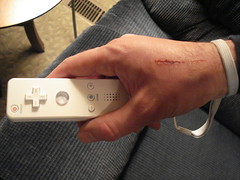| Nintendo Wii Injury (Photo credit: evansonline) |
In our modern era, where political decisions often resemble bumper sticker marketing slogans rather than sensible nuanced policy, simplistic over-reaction is always a danger. A perfect example…the Consumer Product Safety Improvement Act (CPSIA), which President Bush signed in 2008 after lead was found in many childrens’ toys. The law requires every material in products aimed at children under 12 years old be tested by a 3rd party lab for lead levels. It’s a massive undertaking for large stores and a near impossibility for smaller toy makers and retailers.
Most people - including regulators, manufacturers and the impacted retailers - seemed to think the law would be postponed or modified before taking effect February 10th. After all, there isn’t even enough capacity in the nation’s 3rd party testing labs to handle the new workload. No such luck. In fact, as late as Monday, regulators were frantically putting FAQs up on the internet to help retailers, from posh children’s boutiques to thrift stores, figure out what needs to be tested or pulled from shelves.
But the question we should be asking is; is this the most efficient way to protect consumers from a supply chain risk?
This situation reminds me of advice a colleague once had for the toy industry after WalMart and Toys R Us voluntarily imposed new phthalate restrictions on their suppliers. They urged that testing (which smart retailers already do on their own - a scenario that’s NOT allowed under the CPSIA) was only part of the solution, and that retailers must push for greater visibility into their supply chains and hold their vendors accountable when the rules are broken.
Wouldn’t that be a better way to protect children, manufacturers, retailers and…perhaps even a few politicians, who could claim real world results through comprehensive, collaborative risk reduction strategies? I guess that approach won’t fit on a bumper sticker.








